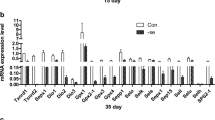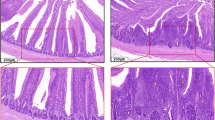Abstract
Selenoprotein has many functions in chicken, and the expression of selenoproteins is closely associated with the selenium (Se) level. However, little is known about the expression patterns of selenoproteins in chicken immune organs. Here, we investigated the effect of dietary Se deficiency on the expressions of 23 selenoproteins in broiler immune organs. In this study, 150 broilers were randomly divided into two groups (75 chickens per group). The chickens were maintained either on a diet supplemented with Se through the addition of 0.2 mg/kg of Se (C group) via sodium selenite or on a Se-deficient granulated diet (L group) until the broilers exhibited an onset of exudative diathesis (ED). Following euthanasia, the samples from the immune tissues (including the spleen, thymus, and bursa of Fabricius) were quickly collected, and the messenger RNA (mRNA) expression levels of 23 selenoproteins were examined by real-time quantitative PCR and analyzed using principal component analysis. The results showed that Se deficiency decreased the mRNA levels of 23 selenoproteins in the thymus, spleen, and bursa of the Fabricius tissues of broiler chickens. Furthermore, we found that among 23 selenoproteins, the mRNA levels of Dio1 in the thymus, Txnrd2 in the spleen, and Txnrd3 in the bursa of Fabricius decreased significantly (90.9 %, 83.3 %, and 96.8 %, respectively). In addition, the principal component analysis (PCA) results suggested that Se deficiency mainly influenced the expression of antioxidative selenoproteins, especially glutathione peroxidases (Gpxs), thioredoxin reductases (Txnrds), and iodothyronine deiodinases (Dios) in chicken immune organs. The results of this study are valuable for understanding the relevance of selenoprotein activity in vivo.






Similar content being viewed by others
References
Aachmann FL, Fomenko DE, Soragni A, Gladyshev VN, Dikiy A (2007) Solution structure of selenoprotein W and NMR analysis of its interaction with 14-3-3 proteins. The Journal of Biological chemistry 282(51):37036–37044. doi:10.1074/jbc.M705410200
Bellinger FP, Raman AV, Reeves MA, Berry MJ (2009) Regulation and function of selenoproteins in human disease. The Biochemical Journal 422(1):11–22. doi:10.1042/BJ20090219
Burk RF, Hill KE, Motley AK, Austin LM, Norsworthy BK (2006) Deletion of selenoprotein P upregulates urinary selenium excretion and depresses whole-body selenium content. Biochim Biophys Acta 1760(12):1789–1793. doi:10.1016/j.bbagen.2006.08.010
Combs GF, Jr., Clark LC, Turnbull BW (2001) An analysis of cancer prevention by selenium. Biofactors 14 (1–4):153–159
Dikiy A, Novoselov SV, Fomenko DE, Sengupta A, Carlson BA, Cerny RL, Ginalski K, Grishin NV, Hatfield DL, Gladyshev VN (2007) SelT, SelW, SelH, and Rdx12: genomics and molecular insights into the functions of selenoproteins of a novel thioredoxin-like family. Biochemistry 46(23):6871–6882. doi:10.1021/bi602462q
Du SQ, Zhou J, Jia Y, Huang KX (2010a) SelK is a novel ER stress-regulated protein and protects HepG2 cells from ER stress agent-induced apoptosis. Arch Biochem Biophys 502(2):137–143. doi:10.1016/j.abb.2010.08.001
Du S, Liu H, Huang K (2010b) Influence of SelS gene silence on beta-mercaptoethanol-mediated endoplasmic reticulum stress and cell apoptosis in HepG2 cells. Biochim Biophys Acta 1800(5):511–517. doi:10.1016/j.bbagen.2010.01.005
Hawkes WC, Kelley DS, Taylor PC (2001) The effects of dietary selenium on the immune system in healthy men. Biol Trace Elem Res 81(3):189–213. doi:10.1385/BTER:81:3:189
Hoffmann PR (2008) Selenium and asthma: a complex relationship. Allergy 63(7):854–856. doi:10.1111/j.1398-9995.2008.01676.x
Hoffmann PR, Berry MJ (2008) The influence of selenium on immune responses. Mol Nutr Food Res 52(11):1273–1280. doi:10.1002/mnfr.200700330
Holben DH, Smith AM (1999) The diverse role of selenium within selenoproteins: a review. J Am Diet Assoc 99(7):836–843. doi:10.1016/S0002-8223(99)00198-4
Kaur P, Bansal MP (2005) Effect of selenium-induced oxidative stress on the cell kinetics in testis and reproductive ability of male mice. Nutrition 21(3):351–357. doi:10.1016/j.nut.2004.05.028
Kiremidjian-Schumacher L, Roy M, Wishe HI, Cohen MW, Stotzky G (1994) Supplementation with selenium and human immune cell functions. II. Effect on cytotoxic lymphocytes and natural killer cells. Biological trace element research 41(1–2):115–127
Lescure A, Rederstorff M, Krol A, Guicheney P, Allamand V (2009) Selenoprotein function and muscle disease. Biochim Biophys Acta 1790(11):1569–1574. doi:10.1016/j.bbagen.2009.03.002
Li JL, Gao R, Li S, Wang JT, Tang ZX, Xu SW (2010) Testicular toxicity induced by dietary cadmium in cocks and ameliorative effect by selenium. BioMetals 23(4):695–705. doi:10.1007/s10534-010-9334-0
Liang Y, Lin SL, Wang CW, Yao HD, Zhang ZW, Xu SW (2014) Effect of Selenium on Selenoprotein Expression in the Adipose Tissue of Chickens. Biological trace element research 160(1):41–48. doi:10.1007/s12011-014-0024-6
Lin SL, Wang CW, Tan SR, Liang Y, Yao HD, Zhang ZW, Xu SW (2014) Selenium Deficiency Inhibits the Conversion of Thyroidal Thyroxine (T-4) to Triiodothyronine (T-3) in Chicken Thyroids. Biological trace element research 161(3):263–271. doi:10.1007/s12011-014-0083-8
Liu Y, Zhao H, Zhang Q, Tang J, Li K, Xia XJ, Wang KN, Li K, Lei XG (2012) Prolonged dietary selenium deficiency or excess does not globally affect selenoprotein gene expression and/or protein production in various tissues of pigs. The Journal of Nutrition 142(8):1410–1416. doi:10.3945/jn.112.159020
Liu CP, Fu J, Lin SL, Wang XS, Li S (2014) Effects of dietary selenium deficiency on mRNA levels of twenty-one selenoprotein genes in the liver of layer chicken. Biol Trace Elem Res 159(1–3):192–198. doi:10.1007/s12011-014-0005-9
Loflin J, Lopez N, Whanger PD, Kioussi C (2006) Selenoprotein W during development and oxidative stress. J Inorg Biochem 100(10):1679–1684. doi:10.1016/j.jinorgbio.2006.05.018
Mariotti M, Ridge PG, Zhang Y, Lobanov AV, Pringle TH, Guigo R, Hatfield DL, Gladyshev VN (2012) Composition and evolution of the vertebrate and mammalian selenoproteomes. PLoS One 7(3):e33066. doi:10.1371/journal.pone.0033066
Marsh JA, Combs GF, Jr., Whitacre ME, Dietert RR (1986) Effect of selenium and vitamin E dietary deficiencies on chick lymphoid organ development. Proceedings of the Society for Experimental Biology and Medicine Society for Experimental Biology and Medicine 182 (4):425–436
Martin-Romero FJ, Kryukov GV, Lobanov AV, Carlson BA, Lee BJ, Gladyshev VN, Hatfield DL (2001) Selenium metabolism in Drosophila: selenoproteins, selenoprotein mRNA expression, fertility, and mortality. The Journal of Biological Chemistry 276(32):29798–29804. doi:10.1074/jbc.M100422200
McKenzie RC, Rafferty TS, Beckett GJ (1998) Selenium: an essential element for immune function. Immunol Today 19(8):342–345
Novoselov SV, Kryukov GV, Xu XM, Carlson BA, Hatfield DL, Gladyshev VN (2007) Selenoprotein H is a nucleolar thioredoxin-like protein with a unique expression pattern. Journal of Biological Chemistry 282(16):11960–11968. doi:10.1074/jbc.M701605200
Pappas AC, Zoidis E, Surai PF, Zervas G (2008) Selenoproteins and maternal nutrition. Comparative biochemistry and Physiology Part B, Biochemistry & Molecular Biology 151(4):361–372. doi:10.1016/j.cbpb.2008.08.009
Rasmussen LB, Hollenbach B, Laurberg P, Carle A, Hog A, Jorgensen T, Vejbjerg P, Ovesen L, Schomburg L (2009) Serum selenium and selenoprotein P status in adult Danes—8-year followup. Journal of Trace elements in Medicine and Biology : Organ of the Society for Minerals and Trace Elements 23(4):265–271. doi:10.1016/j.jtemb.2009.03.009
Rayman MP (2000) The importance of selenium to human health. Lancet 356(9225):233–241. doi:10.1016/S0140-6736(00)02490-9
Schweizer U, Schomburg L, Savaskan NE (2004) The neurobiology of selenium: lessons from transgenic mice. The Journal of Nutrition 134(4):707–710
Xu SW, Yao HD, Zhang J, Zhang ZW, Wang JT, Zhang JL, Jiang ZH (2013) The oxidative damage and disbalance of calcium homeostasis in brain of chicken induced by selenium deficiency. Biol Trace Elem Res 151(2):225–233. doi:10.1007/s12011-012-9552-0
Yang Z, Liu C, Zheng W, Teng X, Li S (2015) The functions of antioxidants and heat shock proteins are altered in the immune organs of selenium-deficient broiler chickens. Biol Trace Elem Res. doi:10.1007/s12011-015-0407-3
Yao HD, Zhao WC, Zhao X, Fan RF, Khoso PA, Zhang ZW, Liu W, Xu SW (2014) Selenium deficiency mainly influences the gene expressions of antioxidative selenoproteins in chicken muscles. Biol Trace Elem Res 161(3):318–327. doi:10.1007/s12011-014-0125-2
Ye Y, Shibata Y, Yun C, Ron D, Rapoport TA (2004) A membrane protein complex mediates retro-translocation from the ER lumen into the cytosol. Nature 429(6994):841–847. doi:10.1038/nature02656
Yu D, Li JL, Zhang JL, Gao XJ, Xu S (2011) Effects of dietary selenium on selenoprotein W gene expression in the chicken immune organs. Biol Trace Elem Res 144(1–3):678–687. doi:10.1007/s12011-011-9062-5
Zhao X, Yao H, Fan R, Zhang Z, Xu S (2014) Selenium deficiency influences nitric oxide and selenoproteins in pancreas of chickens. Biol Trace Elem Res 161(3):341–349. doi:10.1007/s12011-014-0139-9
Acknowledgments
The authors thank the members of the Veterinary Internal Medicine Laboratory, College of Veterinary Medicine, and the Northeast Agriculture University for their help with sample collection.
Author information
Authors and Affiliations
Corresponding authors
Ethics declarations
All of the procedures used in the present study were approved by the Institutional Animal Care and Use Committee of Northeast Agricultural University.
Funding
This study was supported by the National Natural Science Foundation of China (Grant No. 31472161).
Conflict of Interest
The authors declare that they have no competing interests.
Rights and permissions
About this article
Cite this article
Yang, Z., Liu, C., Liu, C. et al. Selenium Deficiency Mainly Influences Antioxidant Selenoproteins Expression in Broiler Immune Organs. Biol Trace Elem Res 172, 209–221 (2016). https://doi.org/10.1007/s12011-015-0578-y
Received:
Accepted:
Published:
Issue Date:
DOI: https://doi.org/10.1007/s12011-015-0578-y




